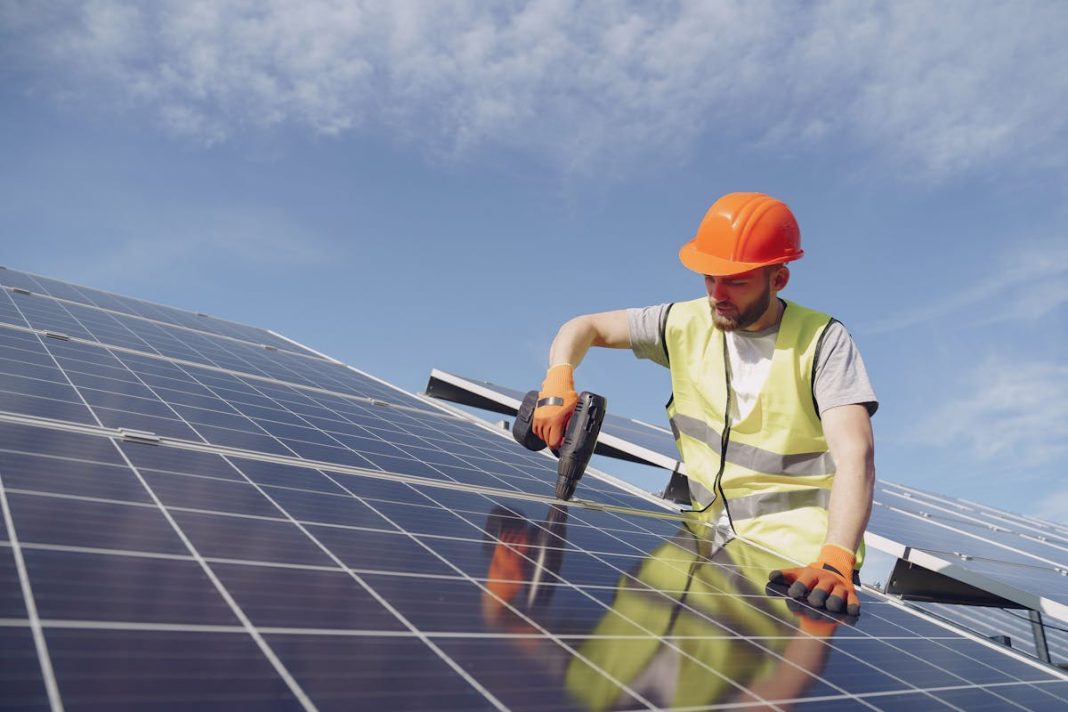In today’s US construction news, learn about how opportunities for sector rotation are appearing in construction-linked industries, according to data from the August 2025 U.S. MBA Mortgage Applications, while the energy sector is showing signs of increasing caution. On the other hand, the power sector has been consistently constructing more solar power plants than any other sort of power plant for the past few years. Lastly, Durham Tech Community College in Durham, North Carolina, USA, has awarded a contract to the Swedish construction giant Skanska to develop a new health sciences complex.
Application for a U.S. MBA Mortgage Showcase the Housing Market’s Upswing
Original Source: U.S. MBA Mortgage Applications Signal Housing Market Momentum: Construction Gains, Energy Caution
The U.S. MBA Mortgage Applications data for August 2025 paints a vivid picture of a housing market in motion, with sector rotation opportunities emerging in construction-linked industries and growing caution warranted in the energy sector. The latest figures reveal a 3.1% weekly increase in total mortgage applications, driven by a 5% surge in the Refinance Index—the highest level since April 2025. This refinance boom, fueled by declining 30-year fixed-rate mortgages (averaging 6.77% as of August 1), has unlocked over $100 billion in home equity, redirecting capital toward home improvements and new construction. Construction: A Gold Rush for Housing and Materials The construction sector is poised to benefit from this refinance-driven liquidity. Housing starts are projected to rise 4–5% in August 2025, with homebuilders like Lennar (LEN), PulteGroup (PHM), and Toll Brothers (TOL) seeing strong performance. Materials suppliers such as Vulcan Materials (VMC) and Caterpillar (CAT) are also gaining traction as demand for concrete, machinery, and logistics intensifies. Investors are advised to overweight construction ETFs like the Homebuilders Select Sector SPDR Fund (XHB) and Construction Materials Select Sector SPDR Fund (ITB), which have outperformed the S&P 500 by 18% year-to-date. The refinance surge has also spurred demand for home improvement products, benefiting companies like Masco (MAS) and Whirlpool (WHR). Meanwhile, residential REITs such as Equity Residential (EQR) and Ventas (VTR) are capitalizing on a shift in borrower behavior toward rental equity, as refinanced homeowners enter the rental market or invest in multi-family units. Energy: Regulatory Uncertainty and Renewable Competition In contrast, the energy sector faces a complex landscape. The U.S. energy market is navigating regulatory shifts, including potential changes under a Trump administration that could prioritize LNG exports and natural gas infrastructure. While this may temporarily boost fossil fuel producers, the long-term outlook is clouded by the rapid expansion of renewables. The Inflation Reduction Act (IRA) has accelerated clean energy investments. with over 36 GW of new renewable and storage capacity expected by 2030. Natural gas, though positioned as a bridge fuel, faces margin compression from accelerated refinance-driven prepayments and competition from renewables. Mortgage REITs (mREITs) like Annaly Capital (NLY) and AGNC Investment (AGNC) are under pressure, and investors are advised to hedge mREIT risks using inverse ETFs like the ProShares Short REIT (SREZ). Strategic Sector Rotation:Construction vs. Energy The MBA data underscores a strategic divergence: while refinance activity surges, purchase demand grows modestly (0.1% week-over-week), historically leading to an 8% underperformance in the consumer discretionary sector. Investors should underweight retail and travel while overweighting construction, materials, and infrastructure equities. The Federal Reserve’s policy decisions will be pivotal. A potential rate cut in Q4 2025 could amplify refinancing gains, but a rate hike would trigger margin compression in mREITs and slow homebuilding. Energy investors must also monitor the interplay between LNG export policies and renewable growth, as the latter gains momentum from AI-driven efficiency and green hydrogen innovation. Conclusion: Aligning Portfolios with Market Signals The MBA Mortgage Market Index’s surge to 275.8—a level not seen since 2021—signals a pivotal shift in capital flows toward construction and infrastructure. Energy investors, however, must navigate regulatory and market headwinds. By overweighting construction ETFs, hedging mREIT exposure, and staying attuned to Fed policy, investors can capitalize on housing market momentum while avoiding overexposure to a sector facing structural challenges. In this dynamic environment, strategic sector rotation remains the key to maximizing returns.
Construction of Solar Plants in the Us is Currently Breaking Records
Original Source: US solar plant construction is on a record-breaking spree — for now
Still, the U.S. is on course to add a record amount of solar capacity this year despite Trump’s efforts to block renewables.
For several years, the power industry has built more solar power plants than any other sort. According to a federal Energy Information Administration survey, 12 gigawatts of additional solar capacity joined the grid in the first half of the year, and 21 gigawatts more are expected by the end of the year.
Thus, solar will provide almost half of the 64 gigawatts of new electricity capacity projected this year. With battery storage and wind projects, the EIA anticipated 93% of new power plant capacity from sustainable energy in February. In addition, 2025 could break the U.S. power-plant construction record of 58 gigawatts set in 2002 during a natural-gas plant boom.
Those statistics show promising trends: The U.S. is building power plants at a record rate, and most will not create carbon emissions. Renewables and batteries cost less to operate than fossil fuel facilities, lowering electricity bills. These are excellent signs, as electrification, industrial expansion, and an AI computer bubble drive demand for new power production, and consumers struggle with rising electricity bills.
These trends may be short-lived because the Trump administration is blocking clean, cheap energy buildout.
The Republican domestic policy package of this summer terminated wind and solar tax benefits early, escalating the cost of deploying these power plants. The executive branch has opposed public land offshore wind and renewable development. Additionally, the Trump administration is artificially boosting fossil fuel facilities. The Department of Energy is using emergency powers to prevent the shutdown of Michigan’s J.H. Campbell coal-fired plant, forcing consumers to pay millions more to keep an old, uneconomical facility. The DOE may imitate this strategy with other uneconomic fossil-burning facilities due to retire, analysts worry.
Any clean power plants coming up this year were planned, permitted, and under construction before Trump’s policy moves (though his authorities have interrupted fully permitted construction, notably the Empire Wind project off New York). This year’s buildout is the last glimpse of the electrical business serving market demand with modern technologies without U.S. government pushback.
Momentum may propel the solar industry to another record year in 2026. To receive the full tax credit, developers must begin work by the first half of 2026. The administration has lately tightened the definition of “starting,” increasing the urgency to begin. An imminent tax-credit cliff usually prompts a rush to start solar projects so they qualify.
The Trump-era energy measures will not totally transform the solar sector for several years. Gas-plant building is unlikely to equal the solar installation rate. Without a rethinking of U.S. energy policy, power-plant development will decline when we need it most.
Skanska Wins a New $69 Million Us Construction Contract
Original Source: Skanska secures new $69m construction contract in US
Durham Tech Community College has hired Skanska to develop a new health sciences complex in Durham, North Carolina.
The company’s third-quarter 2025 US order bookings will include the $69m contract.
A 7,400 m² three-story structure will be built.
The corporation claimed Durham Tech Community College would house nursing, surgical technology, anesthesia technology, respiratory therapy, clinical research, and occupational therapy programs in this new campus.
The building will have allied health and simulation laboratories, classrooms, student collaboration spaces, and administrative offices in addition to program-specific amenities.
Construction begins in September 2025 and is expected to finish in November 2027.
Skanska won a contract to dehumidify the Verrazzano-Narrows Bridge’s main cable.
The State Metropolitan Transportation Authority inked the Skr2.5bn ($249m) contract. It will appear in the company’s third-quarter 2025 US order bookings.
This project entails designing and implementing an acoustic monitoring system and a primary cable dehumidification system on the bridge’s four cables.
Skanska also won a $91m Pacific Middle School Replacement Project in Des Moines, Washington.
A new three-story facility totaling 132,800 ft² will house 950 kids from sixth to eighth grades.
Pacific Middle School will be replaced by a new building with 40 classrooms, administrative facilities, and instructional support sections.
Summary of today’s construction news
In simple terms, the spike to 275.8 on the MBA Mortgage Market Index indicates a significant change in how resources are allocated toward infrastructure and development, a level not seen since 2021. But energy investors face regulatory and market challenges.
On the other hand, thus, the energy regulations enacted under Trump’s administration will not completely transform the solar market environment for at least a few more years. It is quite unlikely that gas-plant construction will keep up with the rate of solar installations.
Lastly, Skanska has been awarded a contract of $91 million to replace Pacific Middle School in Des Moines, Washington. The goal of this project is to build a brand-new, three-story structure that spans about 132,800 square feet to house 950 sixth through eighth graders.








